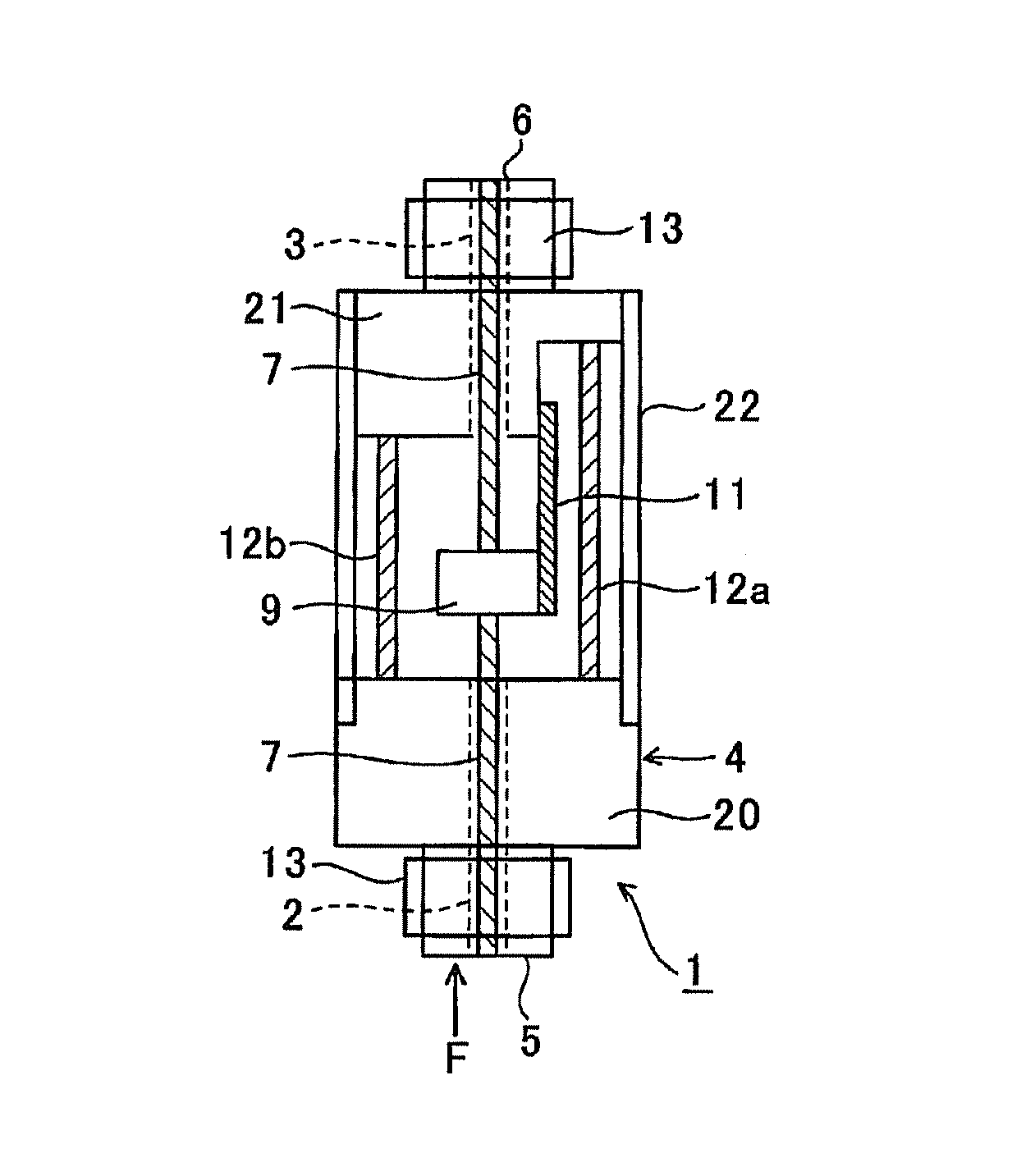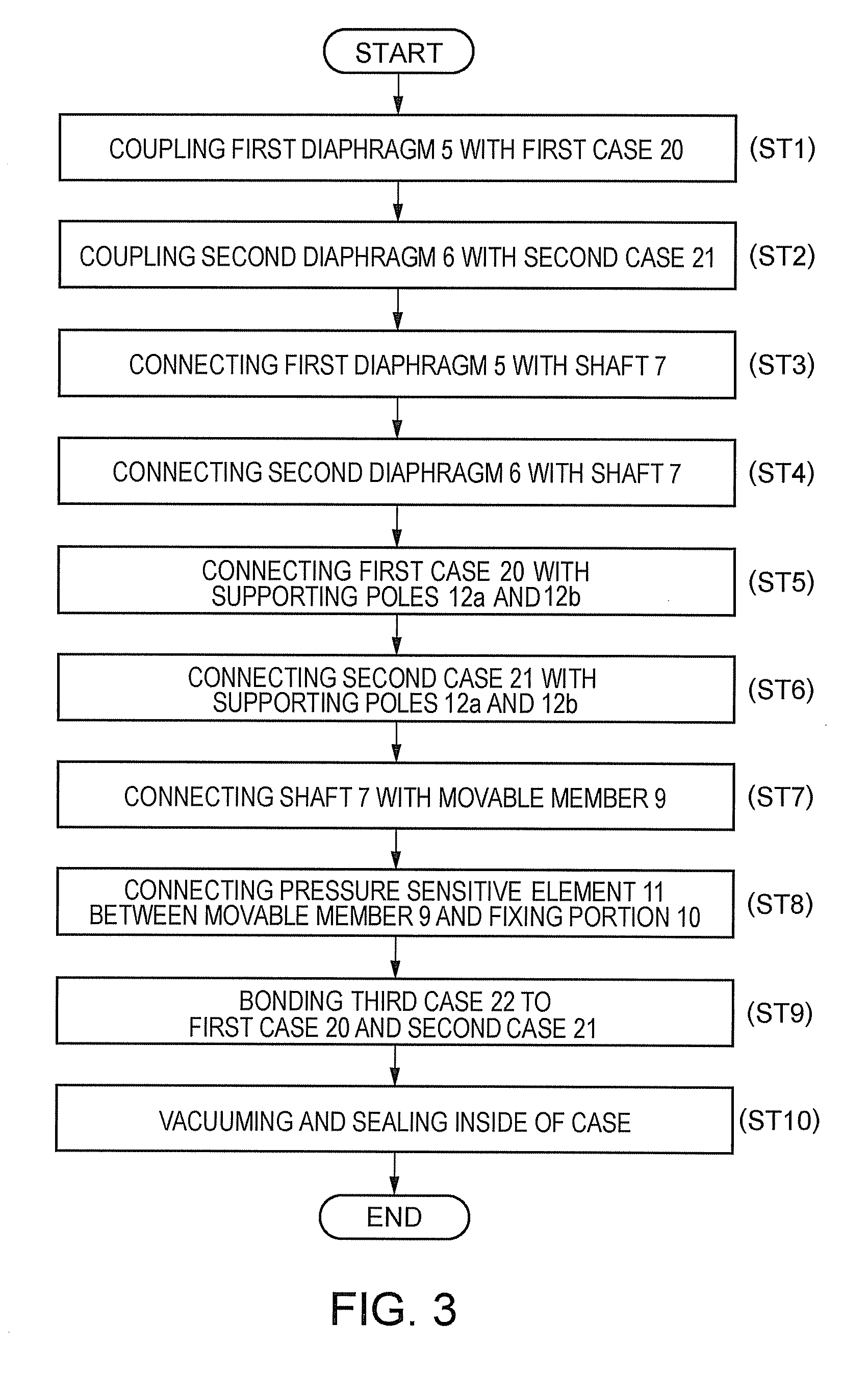Pressure sensor
a technology of pressure sensor and pressure sensor, which is applied in the direction of pressure difference measurement between multiple valves, measurement devices, instruments, etc., can solve the problems of inapplicability of pressure sensor using oil b>110/b> to measurement of pressure of pure liquid that dislikes foreign substances, thermal distortion of components constituting, and error of measured pressure value, etc., to achieve improved temperature characteristics, high measurement accuracy of pressure detection, and large thermal expansion coefficient
- Summary
- Abstract
- Description
- Claims
- Application Information
AI Technical Summary
Benefits of technology
Problems solved by technology
Method used
Image
Examples
first embodiment
[0075]FIG. 1 is a schematic view showing a structure of a pressure sensor according to a first embodiment of the invention.
[0076]This pressure sensor 1 shown in FIG. 1 has a first pressure input orifice 2 and a second pressure input orifice 3 that are used for vacuuming the inside and are disposed to be opposed to each other. Further, the pressure sensor 1 includes a housing 4 for housing components described later. On an end portion of the first pressure input orifice 2, a first diaphragm (a pressure receiving diaphragm) 5 is attached and exposed to outside. The first diaphragm 5 bends depending on a pressure of a liquid that is a measurement object. On an end portion of the second pressure input orifice 3, a second diaphragm (an atmospheric pressure setting diaphragm) 6 is attached. The second diaphragm 6 bends depending on atmospheric pressure. Between the first diaphragm 5 and the second diaphragm 6, a center shaft 7 is disposed as a force transmitting unit and is exposed to out...
second embodiment
[0100]A pressure sensor according to a second embodiment of the invention will now be described.
[0101]FIG. 5 is a schematic view showing a structure of a pressure sensor according to the second embodiment of the invention. The identical numerals are given to the same components as those described above with reference to FIG. 1 and those descriptions will be omitted.
[0102]In the pressure sensor of the first embodiment, the pressure receiving medium with respect to atmospheric pressure is connected with the movable member 9 so as to measure a relative pressure represented by using the atmospheric pressure as a reference of zero. While, in the pressure sensor of the second embodiment, only a pressure receiving medium with respect to a liquid that is a measurement object is connected with the movable member 9 so as to measure an absolute pressure measured with a vacuum state as a reference of zero and a pressure receiving medium with respect to atmospheric pressure is removed.
[0103]In a...
third embodiment
[0109]FIG. 6 is a schematic view showing a pressure sensor 40 according to a third embodiment. FIG. 7 is a perspective view showing a major component of the pressure sensor. FIG. 8 is a perspective view showing a fracture of a part of the pressure sensor. An example shown in the figures is a modification of the pressure sensor for detecting the differential pressure, described in the first embodiment.
[0110]The pressure sensor 40 includes a housing 42 that is a hollow cylindrical chassis. This housing 42 is composed of a flange end plate 44 as a first case (a lower end plate), a hermetic terminal board 46 as a second case (an upper end plate), and a cylinder sidewall 48 as a third case surrounding the circumference of the end plates that are disposed at a distance, so as to be a hollow airtight container. On the flange end plate 44 and the hermetic terminal board 46, a first pressure input orifice 47 and a second pressure input orifice 49 communicating with an internal space are resp...
PUM
| Property | Measurement | Unit |
|---|---|---|
| pressure | aaaaa | aaaaa |
| pressure sensitive | aaaaa | aaaaa |
| force | aaaaa | aaaaa |
Abstract
Description
Claims
Application Information
 Login to View More
Login to View More - R&D
- Intellectual Property
- Life Sciences
- Materials
- Tech Scout
- Unparalleled Data Quality
- Higher Quality Content
- 60% Fewer Hallucinations
Browse by: Latest US Patents, China's latest patents, Technical Efficacy Thesaurus, Application Domain, Technology Topic, Popular Technical Reports.
© 2025 PatSnap. All rights reserved.Legal|Privacy policy|Modern Slavery Act Transparency Statement|Sitemap|About US| Contact US: help@patsnap.com



